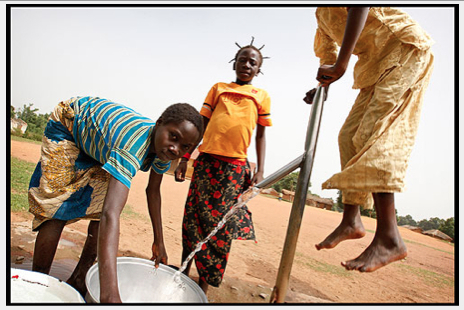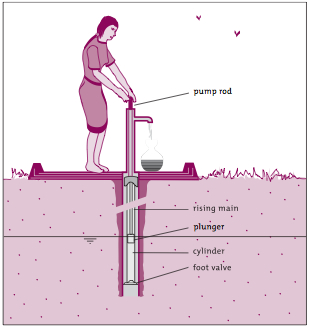Handpumps
Many different kinds of handpumps are frequently installed on hand-dug wells and boreholes in rural areas, including many drought-prone areas. They facilitate a contamination-free method to extract water, but historically handpump functionality has been negatively affected by numerous issues related to user operation & maintenance, which in turn has resulted in a large percentage of handpumps that do not work. However techniques to improve sustainability of handpump installations are possible.
Household-level handpumps, like the Rope pump or the Canzee pump, are relatively cheap options for households to abstract water from a depth of more than 7 m. The rope pump uses washers on a rope that lift up the water through a rising main. The rope is transported down into the well using a rotating wheel at the surface. When turning the wheel, the pump operator lifts the washers and with them the water from the well. The structure is completed with an apron around the pump, a pump supporting construction, and an outlet through which the water flows into a bucket or can. A ]]Canzee pump]] has two PVC tubes (with differring diameters) are used - one inside the other - with non-returning valves on the bottom side. When lowering the inside tube, the water enters in from the outside tube. When lifting the inside tube, its bottom valve closes and the water is lifted from the well. At the same time, the bottom valve of the outer tube opens and water flows into the pump. When the inside tube is lowered again, the process is repeated.
Contents
Suitable conditions
Overall, it seems sensible that handpumps should be installed only when a viable sustainable handpump option has been shown to work in the area.
Construction, operations and maintenance
Direct action handpumps are usually made of PVC and other plastics, and are installed on boreholes of limited depth. A plunger is attached to the lower end of a pump rod, beneath the groundwater level. The user moves the pump rod in an up-and-down mo- tion, using a T-bar handle. On the up-stroke, the plunger lifts water into the rising main, and replacement water is drawn into the cylinder through the foot valve. On the down- stroke, the foot valve closes, and water passes through a one-way valve in the plunger and is lifted on the next up-stroke. Because direct action handpumps have no mechanical advantage, such as the lever or fly-wheel of a deep-well handpump, direct action pumps can only be used to depths from which an individual can physically lift the column of water (about 12 m). However, the mechanical simplicity, low cost and lightweight construction makes these pumps well equipped to meet O&M ob- jectives at the village level.
Costs
Field experiences
References manuals, videos, and links
- Pumps. Different kinds of pumps. PRACTICA Foundation.
Acknowledgements
- Brikke, François, and Bredero, Maarten. Linking technology choice with operation and maintenance in the context of community water supply and sanitation: A reference document for planners and project staff. World Health Organization and IRC Water and Sanitation Centre. Geneva, Switzerland 2003.
- Szánto, Gábor L. et al. Drinking Water Decision Support Tool. PRACTICA Foundation. 2011.
- CARE Nederland, Desk Study Resilient WASH systems in drought prone areas. October 2010.


